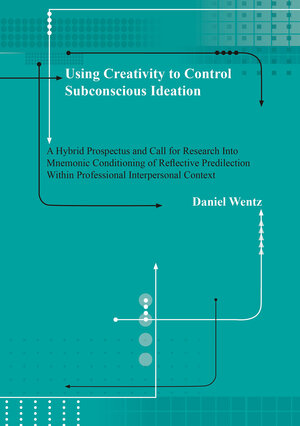Using Creativity to Control Subconscious Ideation
A Hybrid Prospectus and Call for Research Into Mnemonic Conditioning of Reflective Predilection Within Professional Interpersonal Context
von Daniel WentzThe purpose of this hybrid, interrogative study is to present an introspective conditioning method that theoretically activates memory passages linking your subconscious domain and reactionary cognition ... Thus, compelling novel methods of creativity, as discussed herein, for applying your skillset to daily task responsibilities.
Most of our thoughts are processed subliminally, never garnering attention. Conscious recollection of those ideas cultivating your own development is a skill related to operant conditioning. For this research, citations were culled from available resources on creativity. The exposition begins by analyzing those functions of our brain responsible for ideation, which places an onus on defining said condition in relative terms. Through a synthesis of literature, we determine that three traits ultimately dictate how one prioritizes stimuli subconsciously, but their implication is subjectively contingent upon task-related variables influencing knowledge-based goal orientation. (As noted, the research herein is theoretical.)
This book will present three original, complementary models for evaluating different facets of your ideative prioritization process. Users will self-diagnose their thinking profile to validate the efficacy of pertinent professional responsibilities. Then, both a quantitative and qualitative study are presented to guide the reader through sequential evaluation of current objectives, as well as whether their cognitive affinities are facilitating inherent skills (collectively, [1] self-controlled brainstorming session). The research questions will guide conceptualization of subconscious indicators for identifying viable stimuli, plus how users may subsequently train ideative proclivities.
Most of our thoughts are processed subliminally, never garnering attention. Conscious recollection of those ideas cultivating your own development is a skill related to operant conditioning. For this research, citations were culled from available resources on creativity. The exposition begins by analyzing those functions of our brain responsible for ideation, which places an onus on defining said condition in relative terms. Through a synthesis of literature, we determine that three traits ultimately dictate how one prioritizes stimuli subconsciously, but their implication is subjectively contingent upon task-related variables influencing knowledge-based goal orientation. (As noted, the research herein is theoretical.)
This book will present three original, complementary models for evaluating different facets of your ideative prioritization process. Users will self-diagnose their thinking profile to validate the efficacy of pertinent professional responsibilities. Then, both a quantitative and qualitative study are presented to guide the reader through sequential evaluation of current objectives, as well as whether their cognitive affinities are facilitating inherent skills (collectively, [1] self-controlled brainstorming session). The research questions will guide conceptualization of subconscious indicators for identifying viable stimuli, plus how users may subsequently train ideative proclivities.






